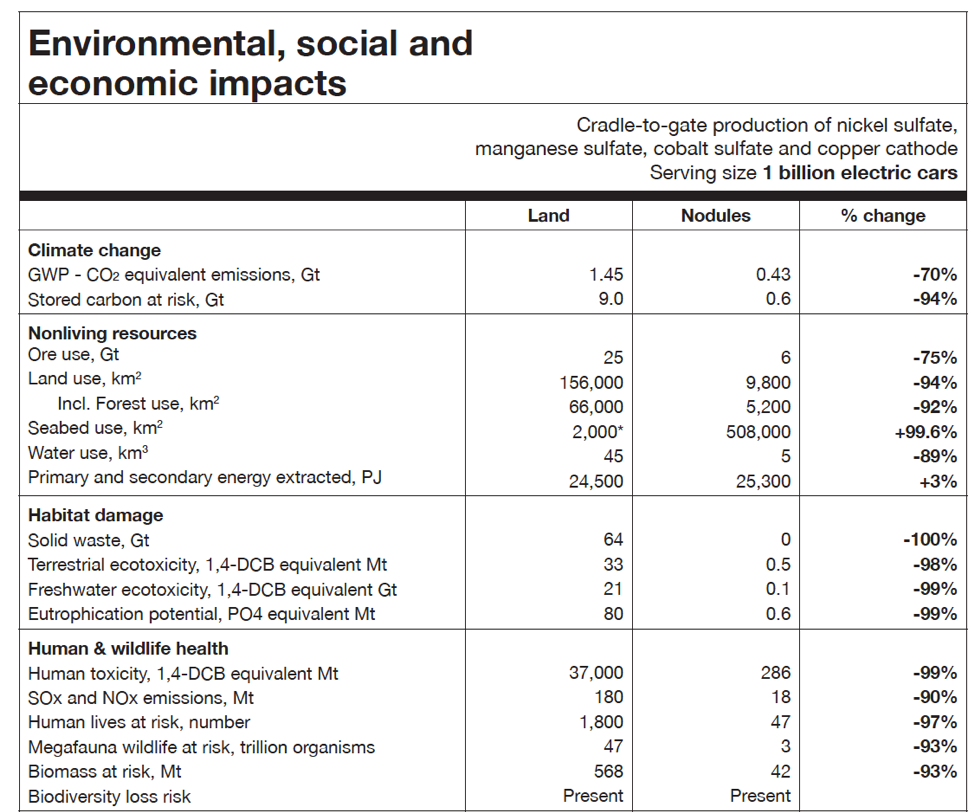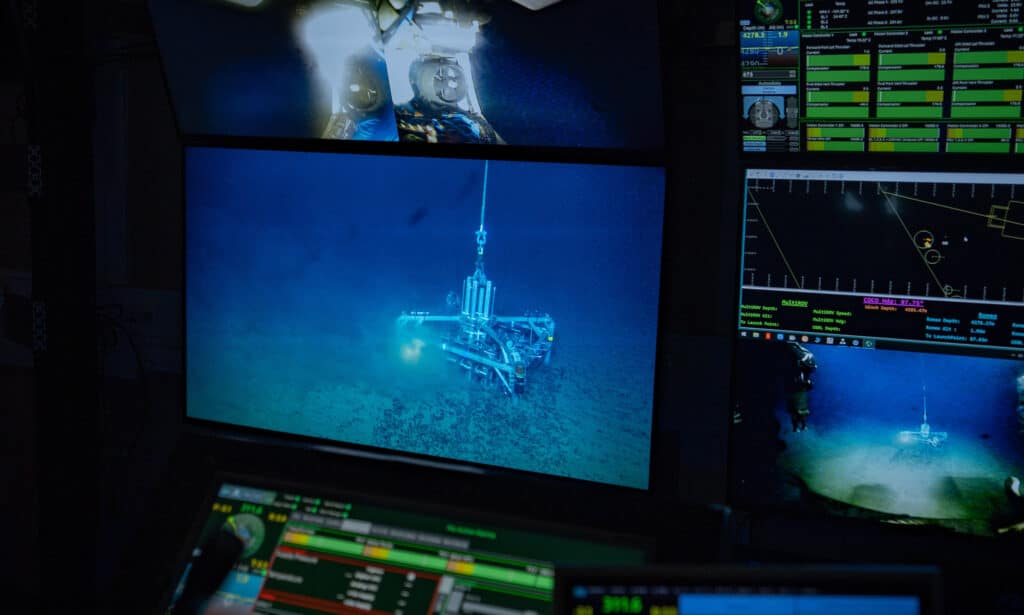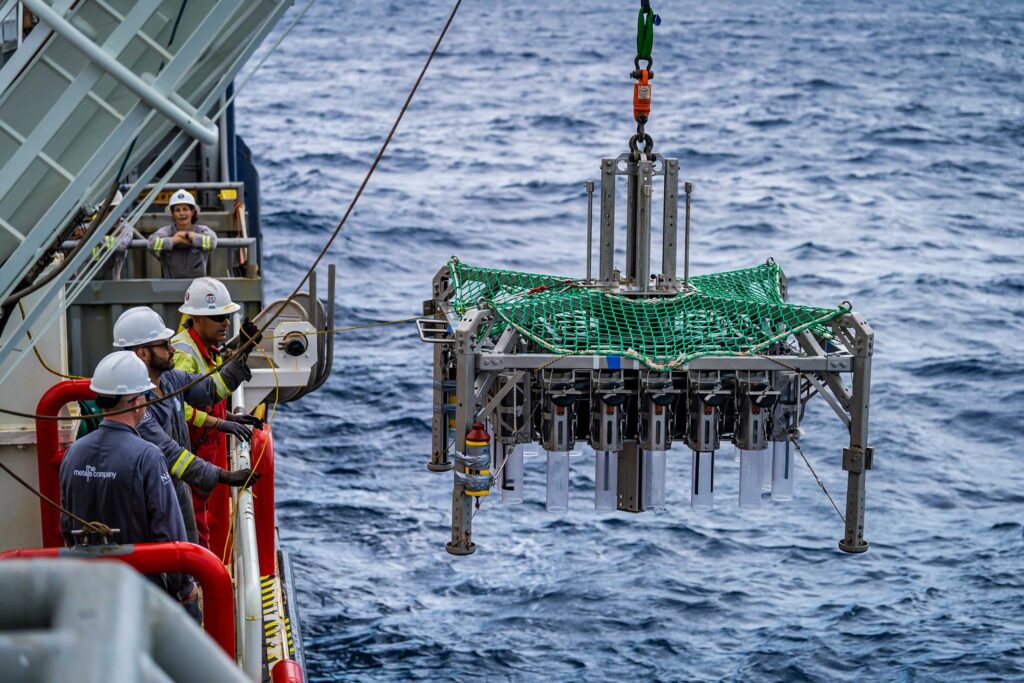To: BMW, Volvo, Google and Samsung SDI
At The Metals Company, we agree that seafloor minerals development should be approached cautiously and with an exacting commitment to science-based impact analysis and environmental protection. A precautionary approach has informed our strategy from the outset, including our mission to provide battery metals sourced from deep-ocean nodules that generate zero solid waste, no toxic tailings, and a fraction of the carbon emissions compared to land-based sources. Such environmental benefits can be achieved only through collecting polymetallic nodules, 4,000 meters deep on the abyssal plain where the abundance of life is up to 1,500 times less than in the vibrant ecosystems on land from where battery metals are currently sourced. Nodules lie unattached on the seafloor, and the extractive processes will not affect the integrity of the seafloor crust. This is different to other resource types that are the impetus for the moratorium being put forth by the World Wildlife Fund (WWF).
The Metals Company shares the goal of BMW, Volvo, Google, WWF and others for achieving a net-zero-emissions future while protecting the oceans and other ecosystems from climate change. Reducing emissions from the transportation sector and energy storage are key to protecting these ecosystems. The largest land-based deposits of nickel — the key ingredient in EV batteries — lie beneath biodiverse, carbon-sequestering ecosystems in Indonesia and the Philippines. Consumer brands that refuse to consider alternative mineral supplies will be complicit in increased deforestation, toxic tailings, child labour (in the case of cobalt), and destruction of terrestrial habitats and carbon sinks. Polymetallic nodules, on the other hand, can deliver key battery metals with up to 90% less carbon emissions equivalent, with no child labour. In order to achieve electrification of the vehicle fleet without destroying terrestrial ecosystems, we need to explore creative solutions for the mineral supply chain including the responsible use of seabed minerals. Car companies like BMW and Volvo that are pledging to go all electric should focus sourcing decisions on actual indicators of impact and once they see the full data, they will most likely reconsider. Where exactly will BMW get the battery metals it needs to fully electrify its products, and with what impact to our climate? Will Volvo customers really prefer rainforest metals in their EVs once they realize their dire impacts on freshwater ecosystems, indigenous peoples, charismatic megafauna and carbon-storing forests?
While recycling will play an important role in meeting future demand, it is irresponsible for major companies to advance the notion that this will be sufficient for the transition to electric vehicles given the current lack of available material for recycling. We will need a massive injection of these metals to build up a sufficient stock if we are to stop extracting from the planet and enable a closed-loop economy.
These considerations are important and warrant rich discussion and debate. Moreover, sourcing decisions should be based on research and data. A life cycle sustainability analysis on battery metals demonstrates that obtaining critical metals from ocean nodules has the least planetary impact in terms of biodiversity, carbon, ecosystem services and human communities. We believe the science is on our side, and that the consumers ultimately will be, too.
Finally, the science that WWF is calling for is the same science we are doing. No extraction of ocean nodules can take place until rigorous, multi-year environmental impact studies are conducted, vetted, reviewed and approved. If this peer-reviewed science, which is a major contributor to society’s knowledge of the deep sea, shows that the risks outweigh the benefits, the global community through the International Seabed Authority — not WWF — can decide that extraction will not occur.
The Metals Company stands ready to discuss responsible polymetallic nodule collection with innovative automakers like BMW and Volvo, as it’s clear that WWF has not shared with you the full picture. You will need to own the impacts of your growing battery supply chain, and we can walk you through the ESG data that define the trade-offs before us as we decarbonize the economy. We look forward to being part of the bright future promised by electrification, most recently in the context of US President Biden’s call for substantial investments in electric vehicle infrastructure, manufacturing, and the secure supply chains to support it.
Some Notes Comparing Land-based Ores to Polymetallic Nodules for Building EV Batteries
Solid Processing Waste/Tailings
Mining metals on land is incredibly wasteful. Sourcing, processing, and refining the metals used in a single electric vehicle (EV) battery creates 64 tons of waste. Multiply that by one billion EVs—the number expected by 2047—and the result is 64 gigatons, including 38 gigatons of solid waste and 25 gigatons of toxic tailings. This waste seeps into the soil and contaminates groundwater near mines, which are often located in areas of high biodiversity rainforests. In seismic regions like Indonesia, this waste is pumped into the Coral Triangle. This isn’t sustainable.
Polymetallic nodules, located in the sparse and desert-like abyssal seafloor, are composed of nearly 100% usable metals. Sourcing metals from nodules reduces solid waste streams by 88%, with no toxic tailings or residues.
CO2 Emissions
Mining on land is incredibly carbon intensive. Mining operations emit 13 tons of CO2 to mine the metals in a single EV battery. Multiply that by one billion EVs, and the result is 13 gigatons. We can’t address the climate crisis by displacing carbon emissions from one part of the supply chain to another. If we really want to decarbonize, we need to actively sequester atmospheric carbon—and we need a better source of battery metals.
Producing these metals from polymetallic nodules is 90% less carbon intensive than from mined metals. Collecting them produces 70% fewer emissions. In both direct and indirect emissions, the choice is clear.
Carbon Stores at Risk
Land mining carries a significant risk of disrupting our planet’s natural carbon stores. Geological processes lock carbon away in the earth, and plants and animals process and store vast amounts of carbon across the planet. A typical terrestrial biome contains 15 times more carbon than the abyssal seabed. Land mining not only threatens the plants and animals living where mines operate, but also the release of vast quantities of carbon and methane directly into the atmosphere, magnifying the climate crisis. Mining on land puts the 2,300 gigatons of carbon stocks stored in the world’s vegetation, soil, and detritus at risk of release.
In the abyssal zone of the Clarion Clipperton Zone (CCZ), where The Metals Company operates, carbon and methane are water soluble. There is no known mechanism for sedimentary carbon on the seafloor to rise to the surface, and there is no known methane in the CCZ. Our activity will disturb a small part of the seafloor, and any large particles will settle quickly, the finer particles over time, and any other particles attached to nodules will be returned to a depth scientifically studied to have minimal impact.
Carbon Sequestration
Land mining disrupts not only carbon stores, but the Earth’s natural carbon-capturing processes themselves. Animals, microbes, and human activity release vast amounts of carbon and methane into the atmosphere. These gases are absorbed by plants and locked into their biomass, stored in the soil, and exchanged for oxygen—as long as those plants are protected. In the ocean, a similar process occurs with flora and fauna in the upper depths, where respiration and decomposition combine with photosynthesis to exchange gases with the atmosphere. Producing one EV battery from a terrestrial mine disrupts the sequestration of 105 tons of CO2 in plants, wildlife, detritus, and the soil.
The abyssal seafloor, by contrast, has one of the lowest sequestration rates on the planet—94% lower than land. Over the next century, we can keep 1.5 metric gigatons of CO2 in the ground by producing a billion EV batteries from polymetallic nodules rather than land metals. The Metals Company can work with the carbon cycle, rather than against it.
Land vs. Seafloor Use
Mining requires huge tracts of land on which to operate. It’s important we acknowledge that gathering polymetallic nodules from the seafloor will require operating over even larger areas: more than three times the area needed to mine on land. But there’s a key difference in the level of destruction that a terrestrial mine produces and the impact of collecting nodules on the abyssal seafloor.
Gathering polymetallic nodules does not require digging into sediment, nor does it disrupt carbon sequestration or threaten biodiverse, biomass-heavy carbon sinks such as forests. Changing how we source metals will also keep toxic tailings from leaching into the ocean, and nodule collection will still only take place over 0.14% of the ocean floor. This is a trade-off, but we believe operating in an abyssal desert—to source cleaner metals—is the clear choice.
Water Use
Land mining is a chronic source of freshwater pollution and a massive drain on this precious resource. Forty-five tons of water are needed to mine the metals in a single EV battery. At every stage, land mining produces toxic drainage, leachate (the results of toxic leaching), ponds, and flooding. This risk to freshwater resources threatens ecosystems everywhere.
Collecting polymetallic nodules from the seafloor has no impact on freshwater. It uses 89% less water in processing and collection, and polymetallic nodules are free of toxic quantities of heavy elements. As freshwater becomes more and more scarce, we can make a deliberate choice to move to sustainable transportation by sourcing our metals more safely.
Human Health and Toxicity
Mining on land is perilous to human health. Alongside releasing toxic elements into natural habitats, terrestrial mines can cause cancer and other health issues in nearby communities. Mining is one of the most hazardous occupations in the world. Vulnerable populations in countries with poorly enforced regulations, including children, disproportionately labor in mines. In addition to the 30 million people employed in official mines, another 6 million work in informal, artisanal mines, often under worse conditions.
Sourcing battery metals from polymetallic nodules almost entirely bypasses these issues. Operations in the CCZ are highly regulated by the International Seabed Authority, scientists conduct peer-reviewed studies on its effects, and polymetallic nodules are remarkably free of toxic levels of heavy elements. The result is 99% less toxicity for humans than mining on land and a 97% reduction in human life at risk.
Biomass and Biodiversity at Risk
Mining carries risks both for biomass—the density of living organisms in a given area—and for biodiversity—the variety and variability of life there. Humans are currently causing a sixth extinction. Wildlife populations are rapidly decreasing due to human activity, and 10% of Earth’s species are projected to go extinct every decade.
While sourcing polymetallic nodules from the abyssal seafloor has a small effect on biomass and biodiversity, mining on land has a disproportionately larger impact. 97% of all biomass exists on land, with only 3% in the ocean. Six times more species exist on land than in the ocean. In areas where mines are commonly located, biomass and biodiversity are even higher. Congo, the world’s top cobalt producer, is the 14th most biodiverse. South Africa, the top manganese producer, is the 13th most biodiverse. Indonesia, the top nickel producer, is the 3rd most biodiverse, and Chile, the top copper producer, leads the world in endemic species.
The abyssal seafloor of the CCZ is mainly populated by phytoplankton and microbes. 70% fewer species would be touched by nodule collection and processing than by mining land ores, and 13.5 times less biomass would be impacted.
Social Displacement and Impacts on Indigenous People
Mining and development disproportionately impact indigenous people around the world. Mines frequently breach the rights of indigenous people on their ancestral lands, either through deliberate acts of malice or violence, or through corporate ignorance. By displacing people from their ancestral homes, terrestrial mining also threatens indigenous beliefs, customs, and histories, putting entire cultures at risk.
Producing metals from polymetallic nodules bypasses these issues. While some countries rely on mining for economic prosperity, there is no risk of violating indigenous cultural rights when sourcing nodules. By shifting metal sourcing from terrestrial mines to polymetallic nodules, we can move toward ending an intractable conflict between the rights of indigenous people and the viable locations for mines. We can also uphold the U.N. Declaration on the Rights of Indigenous Peoples, the International Labor Organization’s Indigenous and Tribal Peoples Convention, and the World Bank Operational Manual OP 4.10.






